Surface Diffuse Solar Radiation Determined by Reanalysis and Satellite over East Asia: Evaluation and Comparison
Abstract
1. Introduction
2. Data
2.1. Ground Measurements
2.2. Diffuse Radiation Products
3. Methods
3.1. Validation Metrics
3.2. Time Series Decomposition
4. Results
4.1. Evaluation Against Ground Measurements
4.2. Temporal Difference of Data Accuracy
4.3. Spatial Distribution of Biases
5. Discussion
6. Conclusions
Supplementary Materials
Author Contributions
Funding
Acknowledgments
Conflicts of Interest
References
- Wang, K.; Dickinson, R.; Wild, M.; Liang, S. Evidence for decadal variation in global terrestrial evapotranspiration between 1982 and 2002: 1. Model development. J. Geophys. Res. 2010, 115, D20112. [Google Scholar]
- Wild, M.; Folini, D.; Schär, C.; Loeb, N.; Dutton, E.; König-Langlo, G. The global energy balance from a surface perspective. Clim. Dyn. 2012, 40, 3107–3134. [Google Scholar]
- Wild, M.; Ohmura, A.; Schär, C.; Müller, G.; Folini, D.; Schwarz, M.; Hakuba, M.Z.; Sanchez-Lorenzo, A. The global energy balance archive (GEBA) version 2017: A database for worldwide measured surface energy fluxes. Earth Syst. Sci. Data 2017, 9, 601–613. [Google Scholar]
- Yang, W.; Guo, X.; Yao, T.; Yang, K.; Zhao, L.; Shenghai, L.; Zhu, M. Summertime surface energy budget and ablation modeling in the ablation zone of a martime tibetan glacier. J. Geophys. Res. 2011, 116, D14116. [Google Scholar]
- Wild, M.; Ohmura, A.; Makowski, K. Impact of global dimming and brightening on global warming. Geophys. Res. Lett. 2007, 34, L04702. [Google Scholar]
- Jia, B.; Xie, Z.; Dai, A.; Shi, C.; Chen, F. Evaluation of satellite and reanalysis products of downward surface solar radiation over east asia: Spatial and seasonal variations. J. Geophys. Res. (Atmos.) 2013, 118, 3431–3446. [Google Scholar]
- Mokhtari, A.; Noory, H.; Vazifedoust, M. Improving crop yield estimation by assimilating LAI and inputting satellite-based surface incoming solar radiation into SWAP model. Agric. For. Meteorol. 2018, 250, 159–170. [Google Scholar]
- Rap, A.; Scott, C.E.; Reddington, C.; Mercado, L.; Ellis, R.; Garraway, S.; Evans, M.; Beerling, D.J.; Mackenzie, A.; Hewitt, C.N.; et al. Enhanced global primary production by biogenic aerosol via diffuse radiation fertilization. Nat. Geosci. 2018, 11, 640–644. [Google Scholar]
- Zhang, M.; Yu, G.-R.; Zhuang, J.; Gentry, R.; Fu, Y.-L.; Sun, X.; Zhang, L.-M.; Wen, X.; Wang, Q.-F.; Han, S.-J.; et al. Effects of cloudiness change on net ecosystem exchange, light use efficiency, and water use efficiency in typical ecosystems of China. Agric. For. Meteorol. 2011, 151, 803–816. [Google Scholar]
- Ryu, Y.; Jiang, C.; Kobayashi, H.; Detto, M. Modis-derived global land products of shortwave radiation and diffuse and total photosynthetically active radiation at 5 km resolution from 2000. Remote Sens. Environ. 2017, 204, 812–825. [Google Scholar]
- Mercado, L.; Bellouin, N.; Sitch, S.; Boucher, O.; Huntingford, C.; Wild, M.; Cox, P. Impact of changes in diffuse radiation on the global land carbon sink. Nature 2009, 458, 1014–1017. [Google Scholar] [PubMed]
- Alton, P.; North, P.R.J.; Los, S. The impact of diffuse sunlight on canopy light-use efficiency, gross photosynthetic product and net ecosystem exchange in three forest biomes. Glob. Chang. Biol. 2007, 13, 776–787. [Google Scholar]
- Kanniah, K.; Beringer, J.; North, P.R.J.; Hutley, L. Control of atmospheric particles on diffuse radiation and terrestrial plant productivity: A review. Prog. Phys. Geogr. 2012, 36, 210–238. [Google Scholar]
- Choudhury, B. A sensitivity analysis of the radiation use efficiency for gross photosynthesis and net carbon accumulation by wheat. Agric. For. Meteorol. 2000, 101, 217–234. [Google Scholar]
- Holzman, M.E.; Carmona, F.; Rivas, R.; Niclòs, R. Early assessment of crop yield from remotely sensed water stress and solar radiation data. ISPRS J. Photogramm. Remote Sens. 2018, 145, 297–308. [Google Scholar]
- Lee, M.; Hollinger, D.; Keenan, T.; Ouimette, A.; Ollinger, S.; Richardson, A. Model-based analysis of the impact of diffuse radiation on CO2 exchange in a temperate deciduous forest. Agric. For. Meteorol. 2017, 249, 377–389. [Google Scholar]
- Bódis, K.; Kougias, I.; Jäger-Waldau, A.; Taylor, N.; Szabó, S. A high-resolution geospatial assessment of the rooftop solar photovoltaic potential in the european union. Renew. Sustain. Energy Rev. 2019, 114, 109309. [Google Scholar]
- Qin, J.; Tang, W.; Yang, K.; Lu, N.; Niu, X.; Liang, S. An efficient physically based parameterization to derive surface solar irradiance based on satellite atmospheric products. J. Geophys. Res. Atmos. 2015, 120, 4975–4988. [Google Scholar]
- Kobayashi, H.; Iwabuchi, H. A coupled 1-D atmosphere and 3-D canopy radiative transfer model for canopy reflectance, light environment, and photosynthesis simulation in a heterogeneous landscape. Remote Sens. Environ. 2008, 112, 173–185. [Google Scholar]
- Xia, X.; Wang, P.; Chen, H.; Liang, F. Analyis of downwelling surface solar radiation in China from national centers for environmental prediction reanalysis, satellite estimates, and surface observations. J. Geophys. Res. 2006, 111, D09103. [Google Scholar]
- Copernicus Climate Change Service (C3S). ERA5: Fifth generation of ECMWF atmospheric reanalyses of the global climate. Climate Data Store (CDS) 2017. Available online: https://cds.climate.copernicus.eu/cdsapp#!/home (accessed on 27 April 2020).
- Jiang, H.; Lu, N.; Qin, J.; Tang, W.; Yao, L. A deep learning algorithm to estimate hourly global solar radiation from geostationary satellite data. Renew. Sustain. Energy Rev. 2019, 114, 109327. [Google Scholar]
- Linares-Rodriguez, A.; Ruiz-Arias, J.; Pozo-Vazquez, D.; Tovar-Pescador, J. An artificial neural network ensemble model for estimating global solar radiation from meteosat satellite images. Energy 2013, 61, 636–645. [Google Scholar]
- Lu, N.; Qin, J.; Yang, K.; Sun, J. A simple and efficient algorithm to estimate daily global solar radiation from geostationary satellite data. Energy 2011, 36, 3179–3188. [Google Scholar]
- Zhang, X.; Liang, S.; Zhou, G.; Wu, H.; Zhao, X. Generating global land surface satellite incident shortwave radiation and photosynthetically active radiation products from multiple satellite data. Remote Sens. Environ. 2014, 152, 318–332. [Google Scholar]
- Jiang, H.; Yang, Y.; Bai, Y.; Wang, H. Evaluation of the total, direct, and diffuse solar radiations from the ERA5 reanalysis data in China. IEEE Geosci. Remote Sens. Lett. 2020, 17, 47–51. [Google Scholar]
- Soni, V.; Pandithurai, G.; Pai, D. Evaluation of long-term changes of solar radiation in india. Int. J. Climatol. 2012, 32, 540–551. [Google Scholar]
- Wang, Y.; Trentmann, J.; Yuan, W.; Wild, M. Validation of CM SAF CLARA-A2 and SARAH-E surface solar radiation datasets over China. Remote Sens. 2018, 10, 1977. [Google Scholar]
- Zhang, X.; Liang, S.; Wild, M.; Jiang, B. Analysis of surface incident shortwave radiation from four satellite products. Remote Sens. Environ. 2015, 165, 186–202. [Google Scholar]
- Yang, S.; Wang, X.; Wild, M. Homogenization and trend analysis of the 1958-2016 in-situ surface solar radiation records in China. J. Clim. 2018, 31, 4529–4541. [Google Scholar]
- Greuell, W.; Meirink, J.F.; Wang, P. Retrieval and validation of global, direct, and diffuse irradiance derived from SEVIRI satellite observations. J. Geophys. Res. (Atmos.) 2013, 118, 2340–2361. [Google Scholar]
- Ridley, B.; Boland, J.; Lauret, P. Modeling of diffuse solar fraction with multiple predictors. Renew. Energy 2010, 35, 478–483. [Google Scholar]
- Huang, G.; Li, Z.; Li, X.; Liang, S.; Yang, K.; Wang, D.; Zhang, Y. Estimating surface solar irradiance from satellites: Past, present, and future perspectives. Remote Sens. Environ. 2019, 233, 111371. [Google Scholar]
- Wild, M. Global dimming and brightening: A review. J. Geophys. Res. 2009, 114, D00D16. [Google Scholar]
- Sanchez-Lorenzo, A.; Enriquez-Alonso, A.; Wild, M.; Trentmann, J.; Vicente-Serrano, S.M.; Sanchez-Romero, A.; Posselt, R.; Hakuba, M.Z. Trends in downward surface solar radiation from satellites and ground observations over europe during 1983–2010. Remote Sens. Environ. 2017, 189, 108–117. [Google Scholar]
- Zhang, X.; Lu, N.; Jiang, H.; Yao, L. Evaluation of reanalysis surface incident solar radiation data in China. Sci. Rep. 2020, 10, 3494. [Google Scholar]
- Shi, G.-Y.; Hayasaka, T.; Ohmura, A.; Chen, Z.-H.; Wang, B.; Zhao, J.-Q.; Che, H.; Xu, L. Data quality assessment and the long-term trend of ground solar radiation in China. J. Appl. Meteorol. Climatol. 2007, 47, 13319–13337. [Google Scholar]
- Roebeling, R.; Putten, E.; Genovese, G.; Rosema, A. Application of Meteosat derived meteorological information for crop yield predictions in Europe. Int. J. Remote Sens. 2004, 25, 5389–5401. [Google Scholar]
- Jiang, H.; Lu, N. High-resolution surface global solar radiation and the diffuse component dataset over China. PANGAEA 2019. [Google Scholar] [CrossRef]
- Jing, W.; Zhang, P.; Zhao, X. A comparison of different grace solutions in terrestrial water storage trend estimation over tibetan plateau. Sci. Rep. 2019, 9, 1765. [Google Scholar]
- Schwarz, M.; Folini, D.; Hakuba, M.; Wild, M. From point to area: Worldwide assessment of the representativeness of monthly surface solar radiation records. J. Geophys. Res. Atmos. 2018, 123, 13857–13874. [Google Scholar]
- Hakuba, M.; Folini, D.; Sanchez-Lorenzo, A.; Wild, M. Spatial representativeness of ground-based solar radiation measurements—Extension to the full Meteosat disk. J. Geophys. Res. 2014, 119, 11760–11771. [Google Scholar]
- Sanchez-Lorenzo, A.; Wild, M.; Trentmann, J. Validation and stability assessment of the monthly mean cm saf surface solar radiation dataset over Europe against a homogenized surface dataset (1983–2005). Remote Sens. Environ. 2013, 134, 355–366. [Google Scholar]
- Espinar, B.; Blanc, P. Satellite images applied to surface solar radiation estimation. In Solar Energy at Urban Scale, 1st ed.; Beckers, B., Ed.; ISTE Ltd: London, UK, 2012; pp. 57–98. [Google Scholar]
- Tang, W.; Li, J.; Yang, K.; Qin, J.; Zhang, G.; Wang, Y. Dependence of remote sensing accuracy of global horizontal irradiance at different scales on satellite sampling frequency. Sol. Energy 2019, 193, 597–603. [Google Scholar]
- Tang, W.; Qin, J.; Yang, K.; Shaomin, L.; Lu, N.; Niu, X. Retrieving high-resolution surface solar radiation with cloud parameters derived by combining modis and mtsat data. Atmos. Chem. Phys. 2016, 16, 2543–2557. [Google Scholar]
- Li, Z.; Zhao, X.; Kahn, R.; Mishchenko, M.; Remer, L.; Lee, K.-H.; Wang, M.; Laszlo, I.; Nakajima, T.; Maring, H. Uncertainties in satellite remote sensing of aerosols and impact on monitoring its long-term trend: A review and perspective. Ann. Geophys. 2009, 27, 2755–2770. [Google Scholar]
- Wang, Y.; Wild, M.; Sanchez-Lorenzo, A.; Manara, V. Urbanization effect on trends in sunshine duration in China. Ann. Geophys. 2017, 35, 839–851. [Google Scholar]
- Qin, J.; Chen, Z.; Yang, K.; Liang, S.; Tang, W. Estimation of monthly-mean daily global solar radiation based on modis and trmm products. Appl. Energy 2011, 88, 2480–2489. [Google Scholar]
- Tang, W.; Yang, K.; He, J.; Qin, J. Quality control and estimation of global solar radiation in China. Sol. Energy 2010, 84, 466–475. [Google Scholar]
- Huang, G.; Li, X.; Huang, C.; Shaomin, L.; Ma, Y.; Chen, H. Representativeness errors of point-scale ground-based solar radiation measurements in the validation of remote sensing products. Remote Sens. Environ. 2016, 181, 198–206. [Google Scholar]
- Hakuba, M.; Folini, D.; Sanchez-Lorenzo, A.; Wild, M. Spatial representativeness of ground-based solar radiation measurements. J. Geophys. Res. 2013, 118, 10362. [Google Scholar]
- Schwarz, M.; Folini, D.; Hakuba, M.; Wild, M. Spatial representativeness of surface-measured variations of downward solar radiation. J. Geophys. Res. Atmos. 2017, 122, 13319–13337. [Google Scholar]
- Wyser, K.; O’Hirok, W.; Gautier, C. A simple method for removing 3-D radiative effects in satellite retrievals of surface irradiance. Remote Sens. Environ. 2005, 94, 335–342. [Google Scholar]
- Wang, K.; Ma, Q.; Wang, X.; Wild, M. Urban impacts on mean and trend of surface incident solar radiation. Geophys. Res. Lett. 2014, 41, 4664–4668. [Google Scholar]
- Imamovic, A.; Tanaka, K.; Folini, D.; Wild, M. Global dimming and urbanization: Did stronger negative ssr trends collocate with regions of population growth? Atmos. Chem. Phys. 2016, 16, 2719–2725. [Google Scholar]
- Yang, S.-K.; Hou, Y.-T.; Miller, A.; Campana, K. Evaluation of the earth radiation budget in NCEP-NCAR reanalysis with ERBE. J. Clim. 1999, 12, 477–493. [Google Scholar]
- Zhang, Q.; Qian, Y.F. Monthly mean surface albedo estimated from NCEP/NCAR reanalysis radiation data. Acta Geogr. Sin. 1999, 54, 309–317. [Google Scholar]
- Hu, G.; Zhao, L.; Wu, X.; Li, R.; Wu, T.; Su, Y.; Hao, J. Evaluation of reanalysis air temperature products in permafrost regions on the Qinghai-Tibetan Plateau. Theor. Appl. Climatol. 2019, 138, 1457–1470. [Google Scholar]
- Pinker, R.; Li, X.; Meng, W.; Yegorova, E. Toward improved satellite estimates of short-wave radiative fluxes—Focus on cloud detection over snow: 2. Results. J. Geophys. Res. 2007, 112, D09204. [Google Scholar]
- Platnick, S.; Meyer, K.; King, M.; Wind, G.; Amarasinghe, N.; Marchant, B.; Arnold, G.; Zhang, Z.; Hubanks, P.; Holz, R.; et al. The MODIS cloud optical and microphysical products: Collection 6 updates and examples from Terra and Aqua. IEEE Trans. Geosci. Remote Sens. 2017, 55, 502–525. [Google Scholar]
- Zhang, J.; Zhao, L.; Deng, S.; Xu, W.; Zhang, Y. A critical review of the models used to estimate solar radiation. Renew. Sustain. Energy Rev. 2017, 70, 314–329. [Google Scholar]
- Voyant, C.; Notton, G.; Kalogirou, S.; Nivet, M.-L.; Paoli, C.; Motte, F.; Fouilloy, A. Machine learning methods for solar radiation forecasting: A review. Renew. Energy 2017, 105, 569–582. [Google Scholar]
- Wang, K.; Ma, Q.; Li, Z.; Wang, J. Decadal variability of surface incident solar radiation over China: Observations, satellite retrievals, and reanalyses. J. Geophys. Res. Atmos. 2015, 120, 6500–6514. [Google Scholar]
- Wang, Y.; Yang, Y. China’s dimming and brightening: Evidence, causes and hydrological implications. Ann. Geophys. 2013, 32, 41–55. [Google Scholar]
- Wu, F.; Fu, C. Assessment of GEWEX/SRB version 3.0 monthly global radiation dataset over China. Meteorol. Atmos. Phys. 2012, 112, 155–166. [Google Scholar]
- Norris, J.; Wild, M. Trends in aerosol radiative effects over China and eapan inferred from observed cloud cover, solar “dimming,” and solar “brightening”. J. Geophys. Res. 2009, 114, D10. [Google Scholar]
- Sweerts, B.; Pfenninger, S.; Yang, S.; Folini, D.; van der Zwaan, B.; Wild, M. Estimation of losses in solar energy production from air pollution in China since 1960 using surface radiation data. Nat. Energy 2019, 4, 657–663. [Google Scholar]
- Hollmann, R.; Müller, R.; Gratzki, A. CM-SAF surface radiation budget: First results with AVHRR data. Adv. Space Res. 2006, 37, 2166–2171. [Google Scholar]
- Perez, R.; Ineichen, P.; Moore, K.; Kmiecik, M.; Chain, C.; George, R.; Vignola, F. A new operational satellite-to-irradiance model. Sol. Energy 2002, 73, 307–317. [Google Scholar]
- Wild, M. Enlightening global dimming and brightening. Bull. Am. Meteorol. Soc. 2012, 93, 27–37. [Google Scholar]
- Wang, K.; Dickinson, R.; Ma, Q.; Augustine, J.; Wild, M. Measurement methods affect the observed global dimming and brightening. J. Clim. 2013, 26, 4112–4120. [Google Scholar]
- Wang, K.; Dickinson, R.; Wild, M.; Liang, S. Atmospheric impacts on climatic variability of surface incident solar radiation. Atmos. Chem. Phys. Discuss. 2012, 12, 9581–9592. [Google Scholar]
- Geogdzhayev, I.; Rossow, W.; Cairns, B.; Carlson, B.; Lacis, A.; Travis, L. Long-term satellite record reveals likely recent aerosol trend. Science 2007, 315, 1543. [Google Scholar]
- Zhang, Y.; Rossow, W.; Lacis, A.; Oinas, V. Calculation of radiative fluxes from the surface to top of atmosphere based on ISCCP and other global data sets: Refinements of the radiative transfer model and the input data. J. Geophys. Res. 2004, 109, D19105. [Google Scholar]
- Ma, Y.; Pinker, R. Modeling shortwave radiative fluxes from satellites. J. Geophys. Res. (Atmos.) 2012, 117, 23202. [Google Scholar]
- Hatzianastassiou, N.; Matsoukas, C.; Fotiadi, A.; Pavlakis, K.; Drakakis, E.; Hatzidimitriou, D.; Vardavas, I. Global distribution of earth's surface shortwave radiation budget. Atmos. Chem. Phys. 2005, 5, 2847–2867. [Google Scholar]
- Kaufman, Y. Atmospheric effect on spatial resolution of surface imagery. Appl. Opt. 1984, 23, 3400. [Google Scholar]
- Yi, B.; Rapp, A.; Yang, P.; Baum, B.; King, M. A comparison of Aqua MODIS ice and liquid water cloud physical and optical properties between Collection 6 and Collection 5.1: Pixel-to-pixel comparisons. J. Geophys. Res. Atmos. 2017, 122, 4528–4549. [Google Scholar]
- Yi, B.; Rapp, A.; Yang, P.; Baum, B.; King, M. A comparison of Aqua MODIS ice and liquid water cloud physical and optical properties between Collection 6 and Collection 5.1: Cloud radiative effects. J. Geophys. Res. Atmos. 2017, 122, 4550–4564. [Google Scholar]
- Tang, W.; Yang, K.; Qin, J.; Li, X.; Niu, X. A 16-year dataset (2000–2015) of high-resolution (3 hour, 10 km) global surface solar radiation. Earth Syst. Sci. Data 2019, 11, 1905–1915. [Google Scholar]
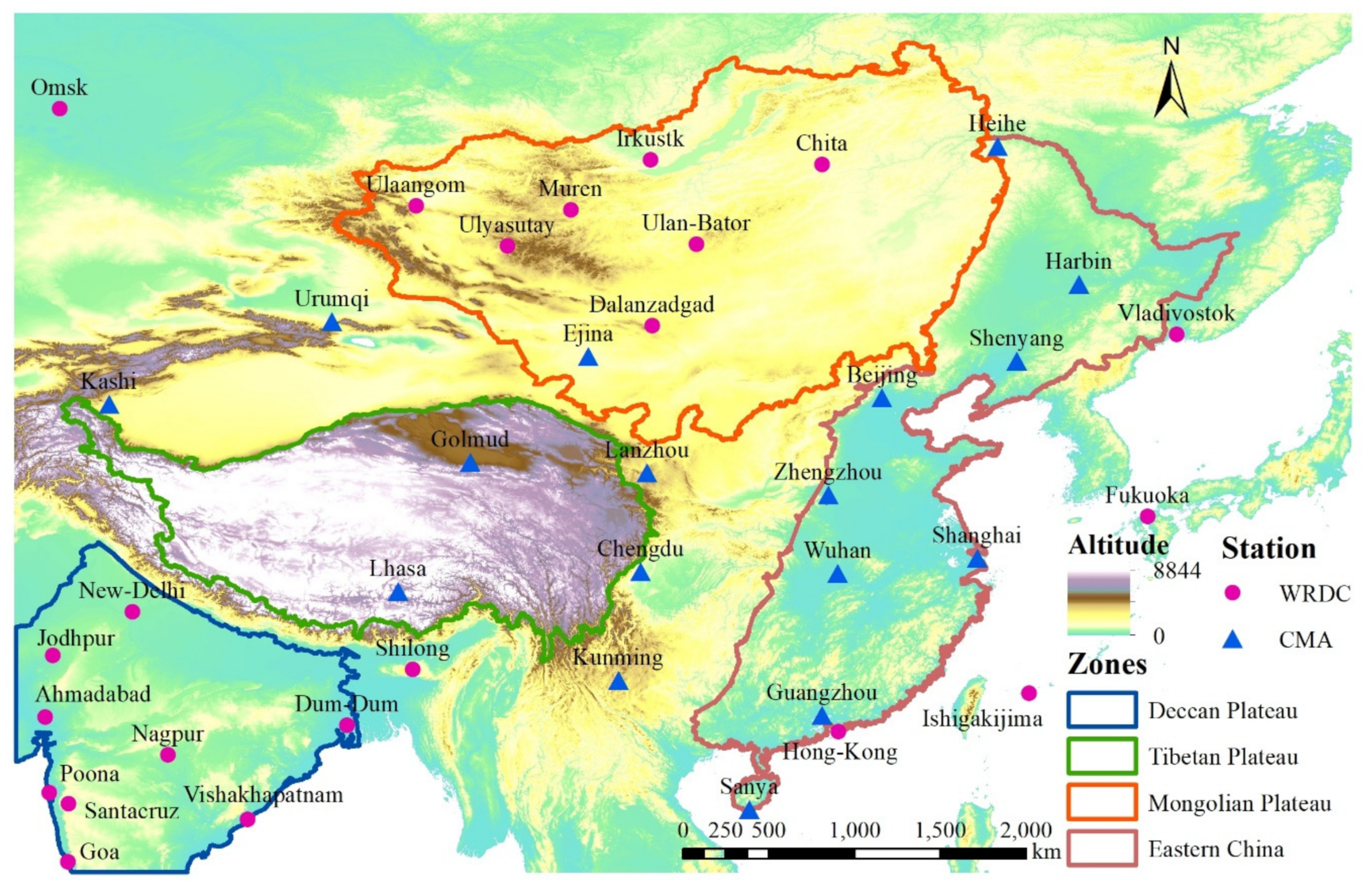
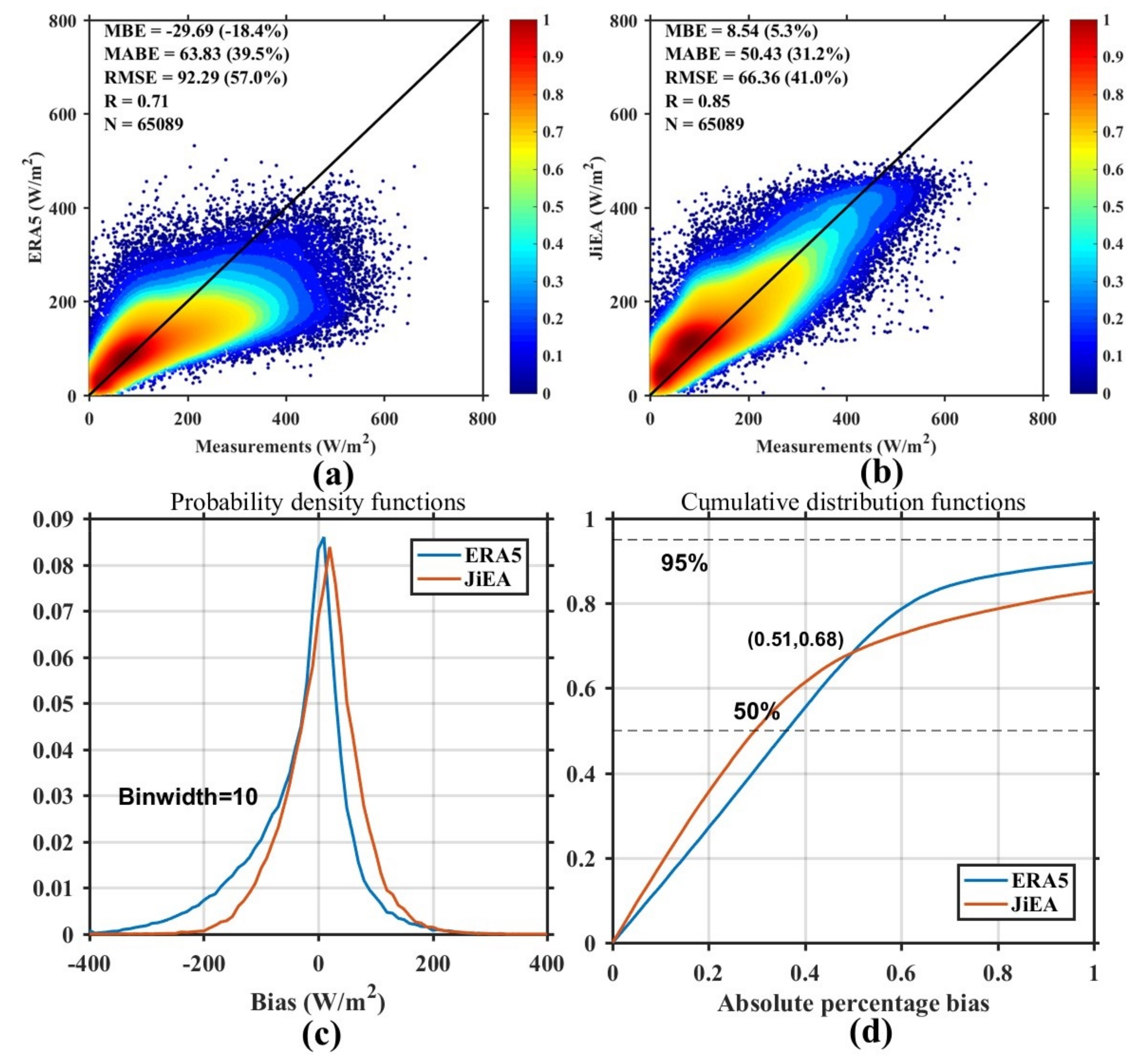
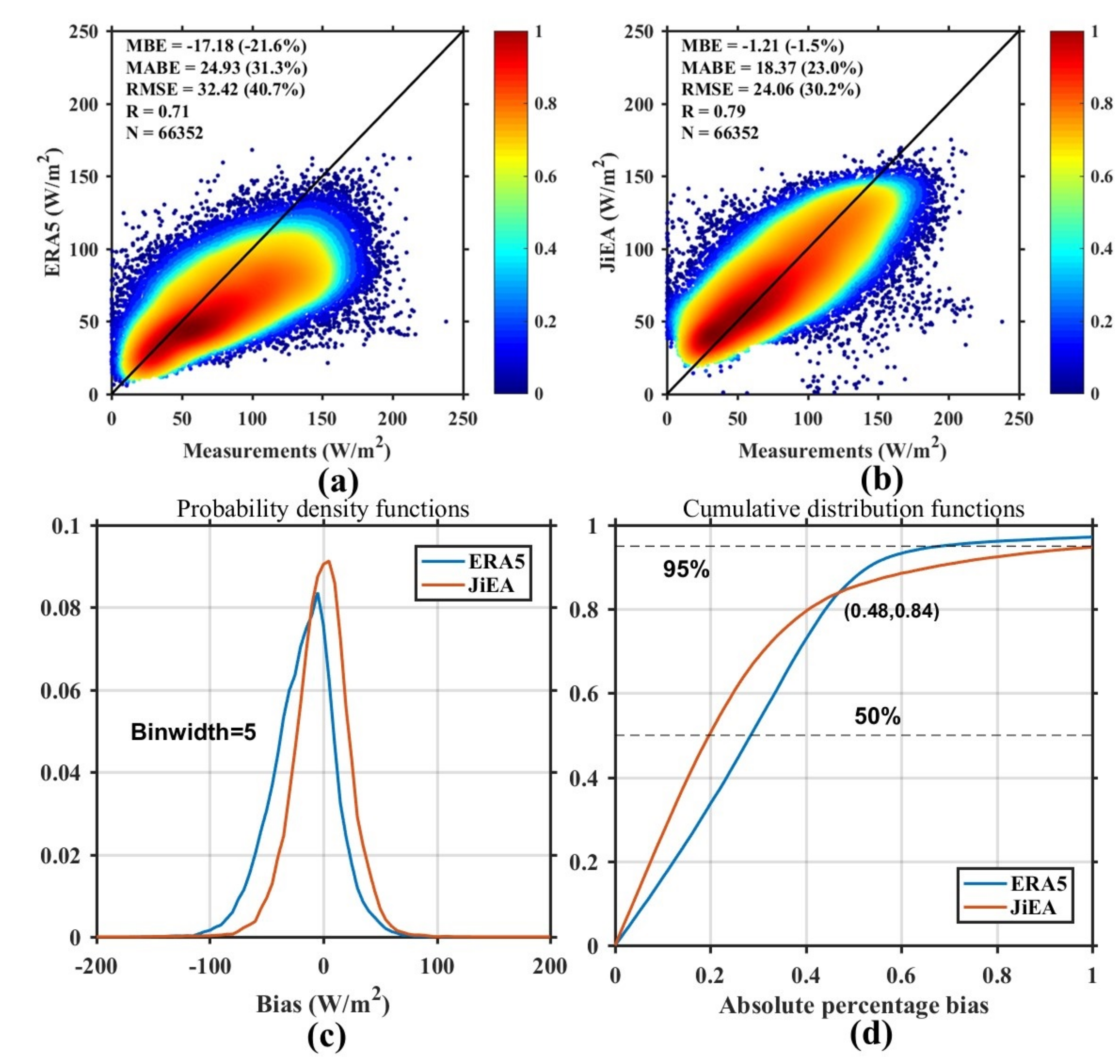
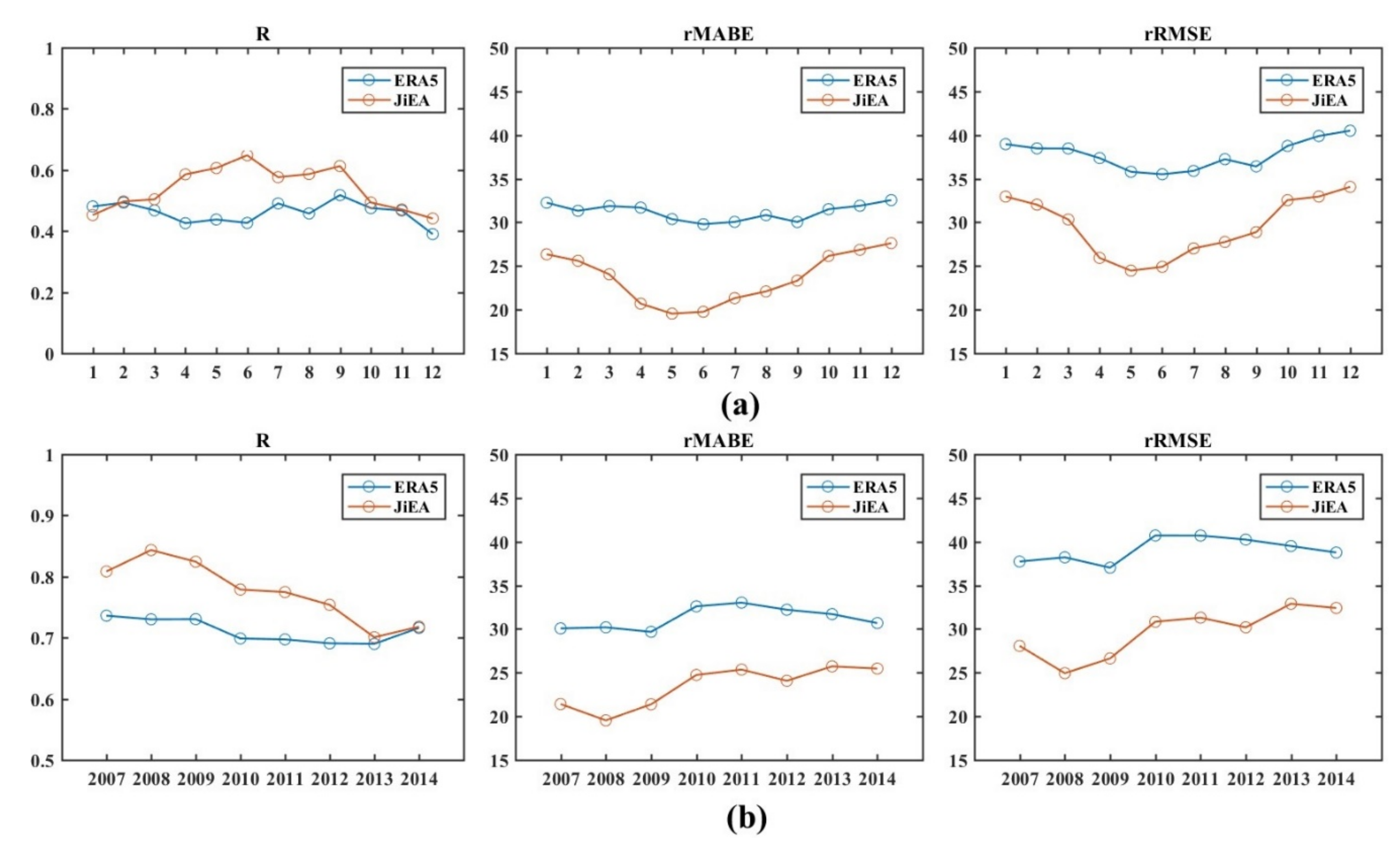
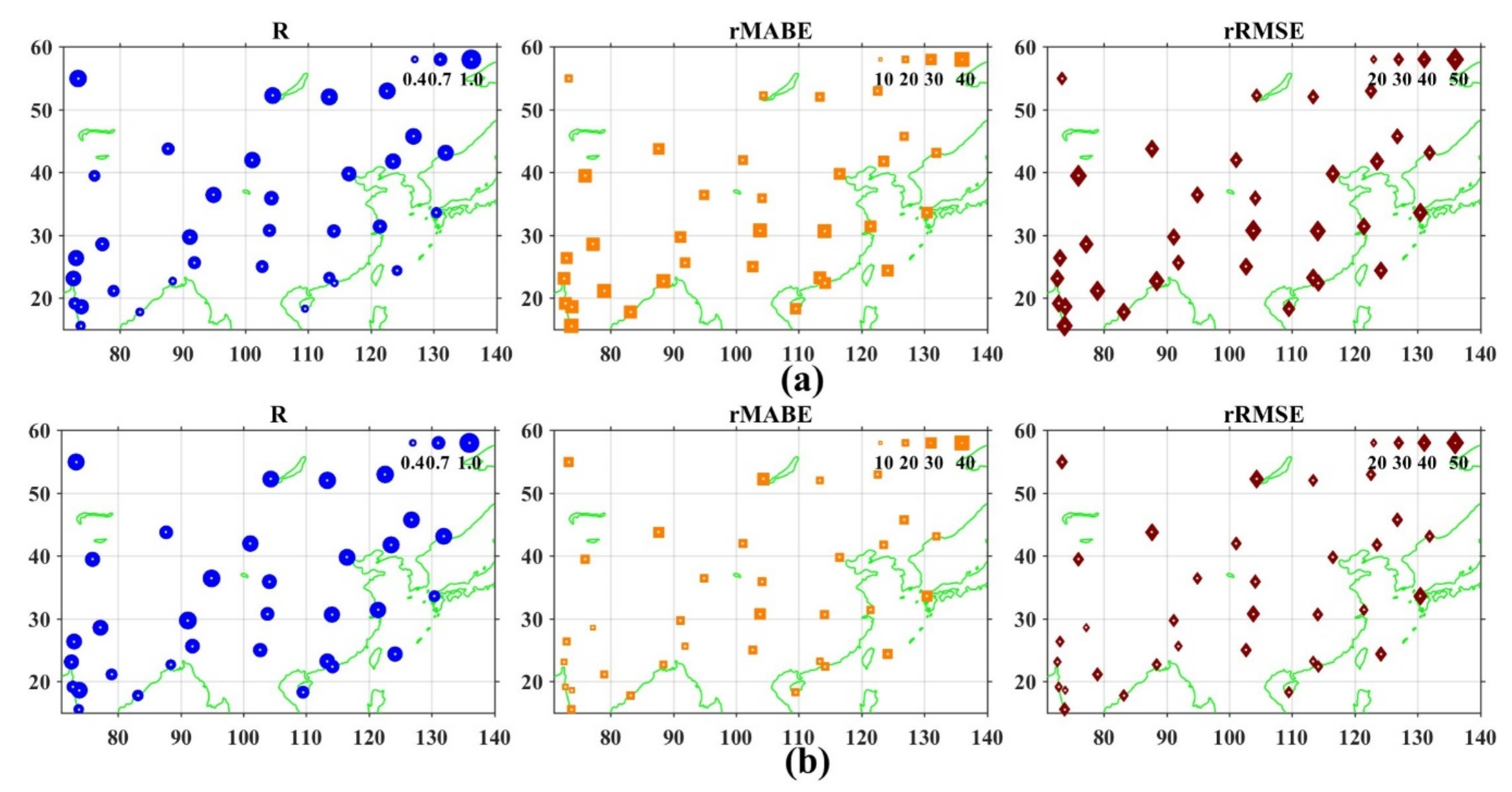
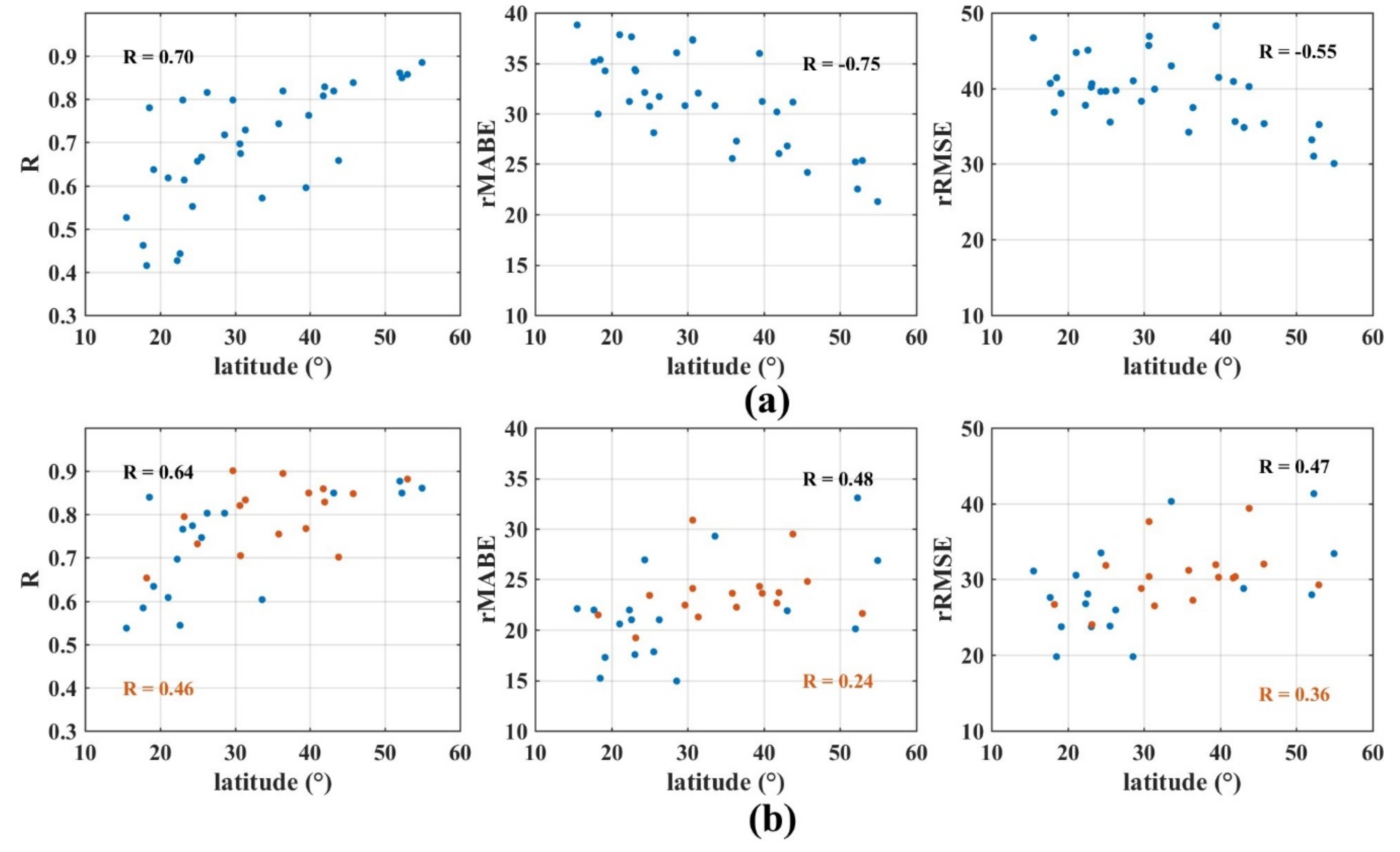


© 2020 by the authors. Licensee MDPI, Basel, Switzerland. This article is an open access article distributed under the terms and conditions of the Creative Commons Attribution (CC BY) license (http://creativecommons.org/licenses/by/4.0/).
Share and Cite
Jiang, H.; Yang, Y.; Wang, H.; Bai, Y.; Bai, Y. Surface Diffuse Solar Radiation Determined by Reanalysis and Satellite over East Asia: Evaluation and Comparison. Remote Sens. 2020, 12, 1387. https://doi.org/10.3390/rs12091387
Jiang H, Yang Y, Wang H, Bai Y, Bai Y. Surface Diffuse Solar Radiation Determined by Reanalysis and Satellite over East Asia: Evaluation and Comparison. Remote Sensing. 2020; 12(9):1387. https://doi.org/10.3390/rs12091387
Chicago/Turabian StyleJiang, Hou, Yaping Yang, Hongzhi Wang, Yongqing Bai, and Yan Bai. 2020. "Surface Diffuse Solar Radiation Determined by Reanalysis and Satellite over East Asia: Evaluation and Comparison" Remote Sensing 12, no. 9: 1387. https://doi.org/10.3390/rs12091387
APA StyleJiang, H., Yang, Y., Wang, H., Bai, Y., & Bai, Y. (2020). Surface Diffuse Solar Radiation Determined by Reanalysis and Satellite over East Asia: Evaluation and Comparison. Remote Sensing, 12(9), 1387. https://doi.org/10.3390/rs12091387





